Whether you’re unfamiliar with the term “parlor guitar” or you just need a few suggestions for which parlor guitar to purchase, this post is for you. Parlor guitars have grown substantially in popularity over the past few years for a couple of reasons.
In this post, I’m going to explain everything you need to know about parlor guitars so that:
- a) you’ll be better educated about what they are and
- b) you can make an informed purchase decision if you choose to want one.
What Are the Best Parlor Guitars?
Let’s get right into some great parlor guitar purchase choices. I’ve broken up the following section into 3 categories: low-budget, medium-budget, and high-budget.
Use these as a guide to help you determine which parlor guitar is right for you.
Low-Budget Best Parlor Guitars
1. Gretsch G9500 Jim Dandy (Editor’s Choice)
The Gretsch G9500 is the least expensive parlor guitar on our list. Gretsch designed this guitar to really bring back the sound and feel of their 30s, 40s, and 50s guitars. The guitar’s body is made of Agathis wood which has similar properties to pinewood which was used on guitars in the 20s.
It comes with 18-frets with the 12th fret meeting the body of the guitar just like many old-style parlors. Of course, you won’t get the same level of quality as some of the more premium guitars, however for a beginner it’s a great choice. Its old-school look really draws the eye’s attention and matched with its decent sound quality and great price, you can’t go wrong. To hear how it sounds and learn a little more about the Gretsch Jim Dandy, check out this demo and review video.
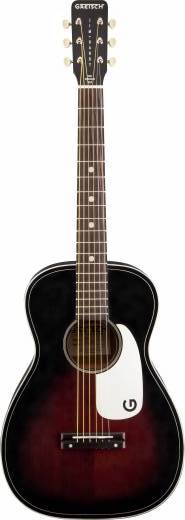
WHAT I LIKE
- Good price
- Long sustain
- No issues with string action
WHAT I DON’T LIKE
- Tuning pegs aren’t very high quality
2) Fender CP-60S
Another great low-cost parlor guitar option for beginners is the Fender CP-60S. The wood on this guitar is mostly laminate therefore you won’t get the same tonal quality as higher-end guitars made of solid wood. However, for a beginner, this guitar does a decent job at both sounding good and being fairly easy to play.
It also comes with a sunburst finish giving it that old parlor guitar style look. Be sure to keep this one in mind if you’re looking for a nice affordable guitar from a well-known reputable brand. To hear how it sounds and learn a little more about the Fender CP-60S, check out this demo and review video.
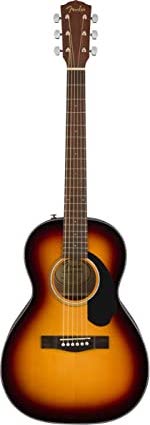
WHAT I LIKE
- Beautiful sunburst finish
- Easy to play (low action)
- Highly reputable brand
WHAT I DON’T LIKE
- String buzz on certain frets
Medium-Budget Best Parlor Guitars
3) PRS SE P20E (Editor’s Choice)
To start us out with medium-budget parlors is the PRS SE P20E. At this price point, this guitar is one of the best and most well-made parlor guitars you can buy.
PRS is known for making super high-quality guitars and this one is no exception.
The PRS SE P20E is actually an acoustic-electric so you can plug it into an amp or a sound system to amplify the amazing tone of this guitar.
From the solid mahogany top, herringbone rosette and accents, and incredibly looking headstock, this guitar is a no-brainer for this price point. To hear how the PRS SE P20E parlor guitar sounds, check out this short demo video.
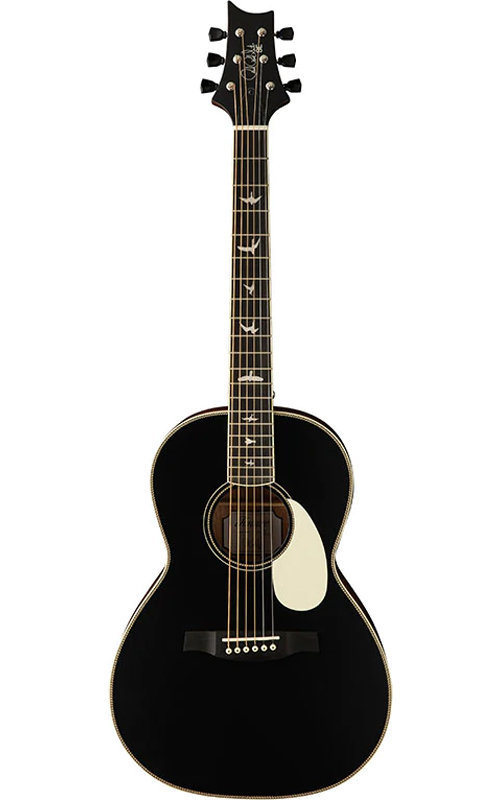
WHAT I LIKE
- Acoustic / Electric
- High quality wood and electronics
- I love the headstock
WHAT I DON’T LIKE
- Tone isn’t super rich
4) Washburn WP33SRS-L
The Washburn WP33SRS-L is another great choice for parlor guitar buyers with a medium budget. This guitar’s body is made from spruce and sapele, while the neck is okoume wood. It offers a very distinct and rustic look both in the body as well as the fretboard.
This guitar is actually built to resemble old Washburn instruments only these days, the company uses modern production techniques to improve reliability and reduce costs. To hear how it sounds and learn a little more about the Washburn WP33SRS-L, check out this demo video.
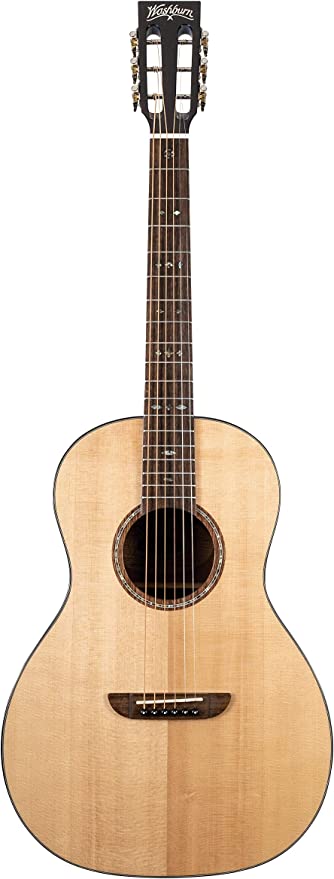
WHAT I LIKE
- Two way truss rod
- Limited lifetime warranty
- Comes with Addario EXP-16 light set phosphor bronze strings
WHAT I DON’T LIKE
- No electronics
High-Budget Best Parlor Guitars
5) Larrivée P-09 (Editor’s Choice)
Finally, we’re breaking into the high-budget parlor guitars. These guitars are the best of the best and although they cost a pretty penny, they’re also many from the highest quality parts and by the most skilled craftspeople. The Larrivée P-09 is a few models up from the parlor that Hadfield brought with him to space. It features all solid wood construction with a Canadian Sitka spruce top and rosewood back and sides.
It truly is one of the best sounding parlor guitars out there. It offers an extremely rich tone with a mix of both modern and old-school, bluesy feel. To hear how the Larrivée P-09 sounds, check out this short demo video.
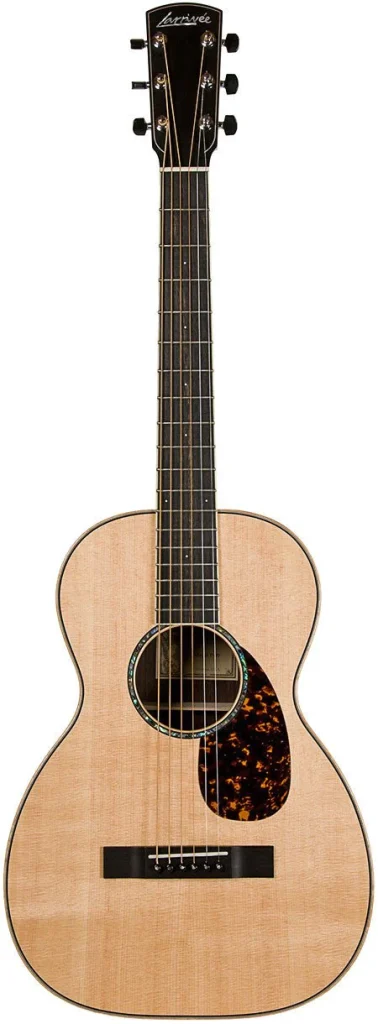
WHAT I LIKE
- Amazing tone
- Great playability
- High-quality craftsmanship
WHAT I DON’T LIKE
- The steep price
6) Alvarez Yairi PYM60HD/14
In line with the same price point as the Larrivée above, the Alvarez Yairi packs a punch. It’s made of a solid spruce top, mahogany back and sides, and an ebony fretboard.
I have an Alvarez myself and can say I absolutely love it. Their guitars are high quality, look amazing, and sounds great.
The Yairi boasts a silky-smooth fingerboard for fast fretting and punchy, crisp sounds making this guitar top-notch. To hear how it sounds and learn a little more about the Alvarez Yairi PYM60HD/14, check out this demo and review video.

WHAT I LIKE
- For a parlor it’s surprisingly warm and rich
- Impeccable look and feel
- High-quality craftsmanship
WHAT I DON’T LIKE
- The steep price
What Is a Parlor Guitar?
A parlor guitar refers to a guitar that has a few distinctive characteristics that set it apart; the most apparent of which is its size.
The term parlor or “parlour” is defined as a sitting room in a private house or simply just a room used to receive guests and have conversations. Back in the day, parlor guitars were usually used in these small to medium-sized rooms as they weren’t overly obtrusive, were compact, and had a distinct sound.

As time progressed, dreadnought guitars grew quickly in popularity. Since they were larger, they could produce a louder and richer tone. Many artists flocked to using these larger-sized guitars, however like many things, parlor guitars have come “full-circle” in a sense.
These days, many artists prefer the tonal and physical qualities of parlor guitars. Their size and shape play a huge role in the way they sound therefore allowing them to stand out from other types of guitars.
Parlor Guitar Differences
As far as what separates a parlor guitar from other types of guitars, there are 3 main differentiators. These include:
- Size – Parlors are typically one of the smallest types of guitars. Although they come with standard fret sizes, the body of the guitar is thinner, and there are often fewer frets than a regular-sized guitar.
- Shape – Parlors vary in shape. However, they are typically less wide than regular-sized guitars and often have slightly elongated bodies
- Tone – Their distinct tone is reminiscent of old-style blue guitarists and emphasizes the midrange. Although parlors may not produce tones as rich as other types of guitars, it’s what sets them apart.
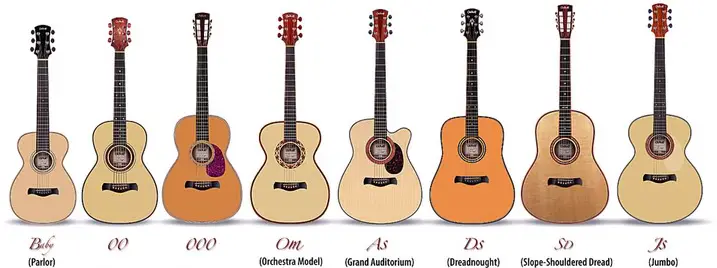
You may be wondering what specific differences exist between a parlor guitar and other types of guitars. Therefore, let’s compare a parlor vs a travel guitar vs a dreadnought guitar.
Parlor vs Travel Guitars
The difference between a parlor and a travel guitar can be somewhat hard to spot at first glance. They’re both small-body guitars and offer their own distinct tone.

However, there are a few differences between parlor vs travel guitars that you may want to take into consideration before making a purchase. These include:
- Parlor guitars tend to have fewer frets than travel guitars
- Parlor guitars tend to have wider necks whereas travel guitars tend to have thinner necks
- Travel guitars may have adapted fret sizes whereas the fret sizes of parlor guitars remain the standard size
- Parlor guitars maintain the standard nut width while travel guitars tend to have a smaller nut width
- Parlor guitar bodies tend to be slightly thinner and longer than travel guitar bodies
As mentioned above, the differences between parlor and travel guitars aren’t all black and white. It could be that some travel guitars have a standard nut width or some parlor guitars have a thin neck for instance. The terms “parlor” and “travel” guitar are also used interchangeably quite often these days.
If you’re specifically in the market for a parlor guitar, just be sure to check it against the features mentioned above. After all, if you enjoy the sound of a travel guitar over a parlor guitar or vice-versa, that’s completely fine. Simply choose whichever guitar provides the best sound and feel.
Parlor vs Dreadnought Guitars
As for the differences between a parlor guitar and a dreadnought guitar, they are much more noticeable. Dreadnought guitars are what’s known as your “standard sized guitar” and are the most widely used and popular style of acoustic guitar around.
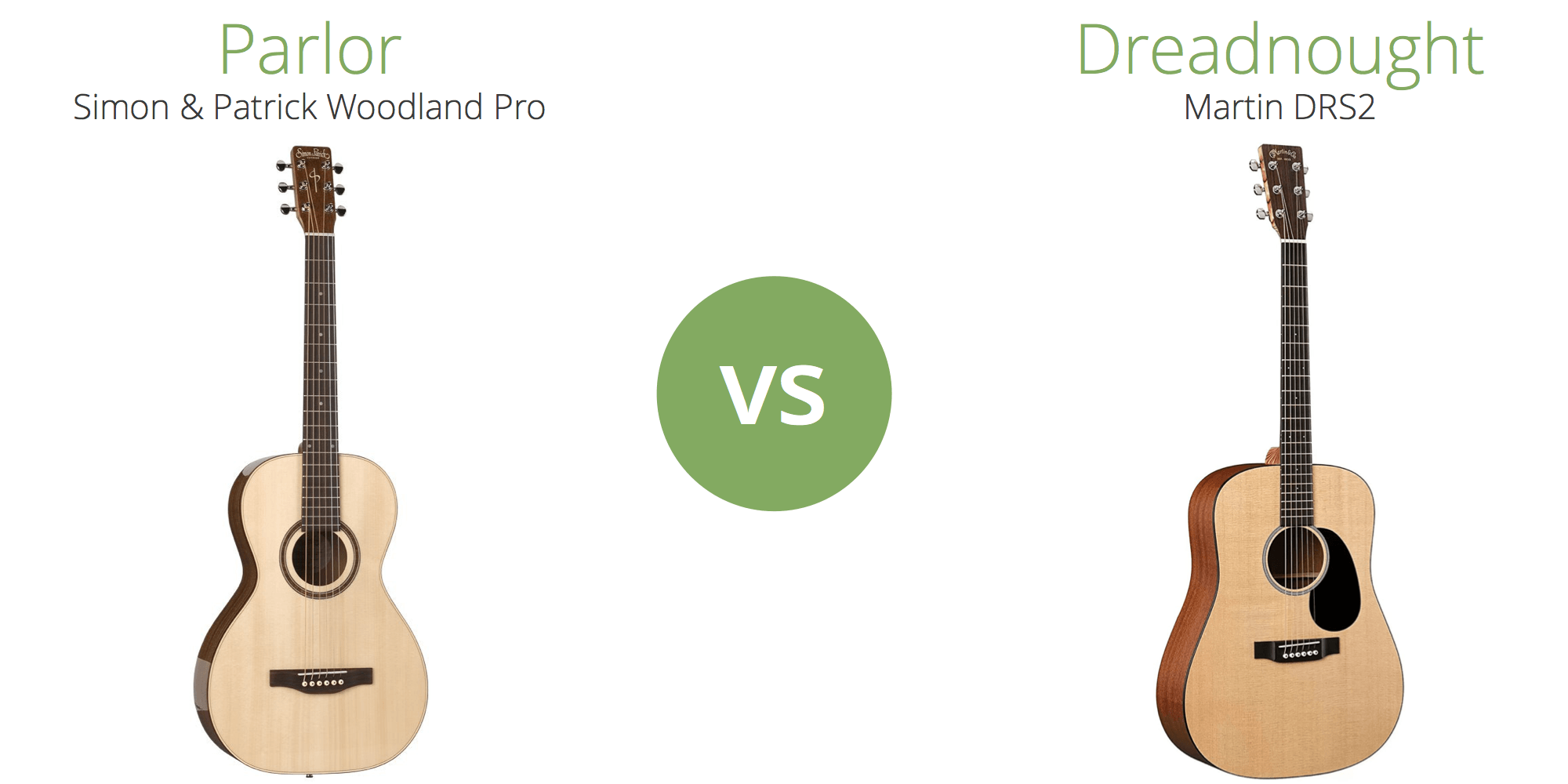
A few differences between parlors and dreadnoughts include:
- Parlors are much more midrange focussed whereas dreadnoughts cover a broader spectrum
- The obvious size difference between dreadnoughts and parlors (dreadnoughts are wider and bulkier)
- Parlors may have fewer frets than dreadnoughts
- Dreadnoughts typically produce more volume due to their larger size
The Renaissance of Parlor Guitars
Parlor guitars were initially popular amongst many blues and folk musicians throughout the late 19th century – 1950’s. After that, during the next 50 years, their popularity dropped significantly as the rise of electric guitars, acoustic dreadnoughts, and concert guitars grew.
Read Next: 50+ Legendary 12 Bar Blues Songs – The Essential List
However, during the turn of the new century (the 2000s) musicians started to take note once again of the novel sound that parlors provided.
One major contributor to the re-birth of parlor guitars was thanks to Canadian astronaut Chris Hadfield. Hadfield recorded an entire album while in space using a Larrivée acoustic parlor guitar.
A video of him playing David Bowie’s “Space Oddity” with his parlor went viral which in turn created a rush of people ordering parlor guitars. This increase in demand also raised the eyebrows of many guitar manufacturers and as a result, many of them started producing more and more parlor guitars to meet demands.
Chris Hadfield’s video in space has now collected over 52 million views, check it out below.
Popular Artists Using Parlor Guitars
Many artists these days have parlor guitars in their collection to allow them to produce a distinct sound that only parlors can provide. For instance, a few popular musicians that use parlors include:
- John Mayer – In his live acoustic performance of “Something Like Olivia“
- Ed Sheeran – In his live performance of “You Need Me, I Don’t Need You“
- The Shins – In their live performance of “Name For You“
The above are just 3 examples of artists using parlor guitars however many others use them whether for practice purposes or for live shows or recording.
Final Thoughts
Hopefully, this overview of parlor guitars has given you some food for thought as to if this style of guitar is right for you. It all depends on your own personal preference, however, parlors certainly do have their advantages and differentiators.
Since they’re smaller than your average dreadnought, they’re excellent for kids or beginner guitarists. They’re also great to use as a travel guitar and perhaps most importantly for seasoned musicians, they offer a distinct sound.





0 Comments